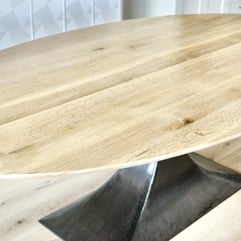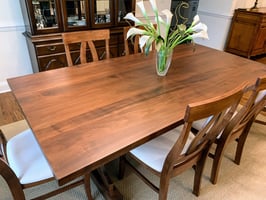When it comes to furnishing your home, custom wood furniture offers a unique blend of...
How to Choose the Perfect Wood Type for Your Custom Furniture
Selecting the right wood for your custom furniture is about finding the perfect balance of style, durability, and value. Each type of wood offers its own unique characteristics, from grain patterns and color to strength and workability. In this guide, we’ll walk you through some of the most popular and versatile options, focusing on what makes them special and how they might suit your next project.
Maple: The Classic All-Rounder
Maple is a perennial favorite among our customers—and for good reason. Known for its light, creamy appearance and fine grain, maple offers exceptional versatility. It’s one of the more affordable hardwoods, making it a great choice for those who want high quality without breaking the bank. Maple’s dense structure makes it incredibly durable and resistant to wear, perfect for pieces that see daily use like dining tables and desks.
One of the most appealing features of maple is its ability to take stain beautifully. Whether you’re looking for a dark, rich finish or a lighter, more natural look, maple can adapt to virtually any style. This flexibility makes it a popular choice for homeowners who want to match their furniture to existing decor.
Walnut: Natural Beauty, No Stain Required
 If maple is the workhorse of custom furniture, walnut is the showstopper. Revered for its rich, chocolate-brown tones and intricate grain patterns, walnut exudes natural elegance. Unlike many other woods, walnut doesn’t need stain to look its best. We simply oil it to enhance its character, allowing the wood’s organic beauty to shine. It is then varnished for supreme durability.
If maple is the workhorse of custom furniture, walnut is the showstopper. Revered for its rich, chocolate-brown tones and intricate grain patterns, walnut exudes natural elegance. Unlike many other woods, walnut doesn’t need stain to look its best. We simply oil it to enhance its character, allowing the wood’s organic beauty to shine. It is then varnished for supreme durability.
Walnut's luxurious look makes it an excellent choice for statement pieces like dining tables, coffee tables, or bar cabinets. While it’s a bit more expensive than maple, its stunning appearance and minimal need for finishing justify the investment.
Mahogany: Timeless Elegance with Contemporary Options
Mahogany has long been synonymous with luxury and tradition. Its deep, reddish-brown hues and fine grain make it a classic choice for formal furniture. However, it’s also surprisingly versatile—especially when quarter-sawn. Quarter-sawn mahogany has a straight, clean grain that works beautifully in contemporary designs, making it a bridge between traditional and modern aesthetics.
formal furniture. However, it’s also surprisingly versatile—especially when quarter-sawn. Quarter-sawn mahogany has a straight, clean grain that works beautifully in contemporary designs, making it a bridge between traditional and modern aesthetics.
Mahogany is also incredibly durable and resistant to warping, making it a good option for large pieces like dining tables, cabinetry, or bookshelves. Its natural richness doesn’t always require staining, but it can be enhanced with a finish that deepens its warm tones.
Red Oak: A Traditional Favorite
 Red oak is a sturdy, dependable hardwood with a distinctive grain and reddish hues that lend a warm, traditional feel to furniture. Its prominent grain pattern adds texture and character, making it a favorite for dining tables, chairs, and flooring.
Red oak is a sturdy, dependable hardwood with a distinctive grain and reddish hues that lend a warm, traditional feel to furniture. Its prominent grain pattern adds texture and character, making it a favorite for dining tables, chairs, and flooring.
While red oak can be stained, its natural reddish tones often show through lighter finishes, giving it a unique, warm look. If you’re aiming for a traditional or rustic style, red oak is an excellent choice. It’s also one of the more affordable hardwoods, offering durability and charm at a reasonable price.
White Oak: A Step Up in Versatility
For those looking for something a bit more refined, white oak offers all the durability of red oak but with a more subtle, neutral palette. Its light color and tight grain make it ideal for modern or minimalist designs. White oak can be stained in a variety of colors, from light, natural finishes to darker, richer tones, or left untouched for its inherent beauty to shine.
White oak is more expensive than red oak but offers superior versatility and a more sophisticated look. Its water resistance also makes it a great choice for outdoor furniture or pieces that may be exposed to excess moisture.
Specialty Woods: Ambrosia Maple and Spalted Maple
For those who want a bold statement piece, specialty woods like ambrosia maple and spalted maple offer unparalleled character. Both types feature striking streaks and patterns caused by natural processes like insect activity or fungal growth. These unique markings make each piece truly one of a kind. Don't worry, the timbers are kiln dried so there are no insects or fungus left in the table!
Ambrosia and spalted maple are not only visually stunning but also sustainable, as they repurpose wood that might otherwise be discarded. These woods are ideal for artistic furniture or accent pieces where their dramatic patterns can take center stage.
.jpg?width=320&height=320&name=IMG_1811%20(1).jpg)

Popular Woods to Avoid
We recommend avoiding certain types of wood for furniture that others may use due to problems that may arise with their longevity, durability and stability over time. Woods such as Pine, Poplar, Cypress, Cedar and Redwood are softer than the woods listed above. They also can have problems with stability, meaning that a table that was delivered beautifully can over time develop warping and cracks.
Potential Red Flag: If you are discussing a piece of furniture with a craftsman and these are the only woods they are willing to use, we warn people that this may be a red flag. These woods are very easy for beginners to work with (which is great, everybody starts somewhere), but if they cannot work with other woods it is a sign they are still in the novice stage. This doe not apply to craftsman who are willing to use these woods, as long as they also work with maple, walnut, mahogany, etc.
How to Choose the Right Wood for Your Furniture
When deciding on a wood type for your custom furniture, consider the following:
- Budget: Maple and red oak are budget-friendly options, mahogany and ambrosia maple are mid-range, while walnut, spalted maple and white oak are premium options.
- Style: For a modern look, white oak or quarter-sawn mahogany work well. For traditional designs, red oak or standard mahogany are excellent choices. Walnut and maple are very versatile.
- Finish Preference: If you love natural wood, walnut and white oak shine without stain. For versatility in color, maple is the best choice.
The type of wood you choose sets the tone for your custom furniture. From maple’s versatility and affordability to walnut’s luxurious beauty and mahogany’s timeless appeal, each wood offers something unique. By understanding the characteristics of each option, you can create a piece that perfectly matches your needs, style, and budget.
Ready to build your perfect piece? Contact us today to explore your wood options and bring your vision to life.



